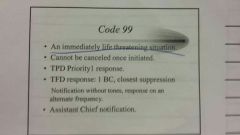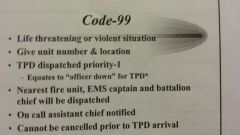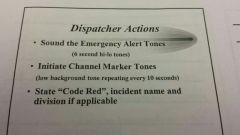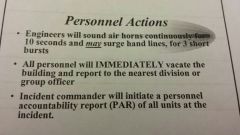![]()
![]()
![]()
Use LEFT and RIGHT arrow keys to navigate between flashcards;
Use UP and DOWN arrow keys to flip the card;
H to show hint;
A reads text to speech;
36 Cards in this Set
- Front
- Back
|
History
|
911 established in Tucson in 1976 Communications section operated by the General Services Division Tucson Fire given responsibility of communications on August 17, 2011 |
|
|
TFD Organization |
Fire Chief Jim Critchley Assistant Chief Laura Baker Deputy Chief Mike Garcia Captain Fred Bair Captain Rob Lewis Superintendent Geoff Kuhn |
|
|
Public Safety Answering Point (PSAP) |
Primary PSAP receives the initial call to 911 Secondary PSAP receives the transferred call from the primary PSAP TFD manages both a primary and secondary PSAP |
|
|
Primary PSAP: 911 |
Determines the problem- law enforcement, fire, or medical Determines jurisdiction Transfers the call to the appropriate jurisdiction Average processing time is 34 seconds Staffing: 4 Training: 1 week classroom then 4-5 weeks on the floor with a trainer Phone lines (trunks) 23 676,655 calls received (04/07/2014-04/07/2015) 259,229 wired and 417,426 (62%) wireless |
|
|
Secondary PSAP: Fire/Medical |
113,208 dispatches for 2014 82,458 Tucson Fire 30,750 County Fire Districts Provides services for 8 fire department/district TFD Northwest FD, Golder Ranch FD, Avra Valley FD, Three Points FD, Picture Rocks FD, Mountain Vista FD Mount Lemmon Fire District Manages medical helicopters for the southeast Arizona region Staffing: 1 supervisor, 2 call takers, 4 city dispatchers, 2 county dispatchers, 2 MEDS dispatchers, 2 Communications Captains |
|
|
Public Safety Dispatcher training (PSD) |
4 weeks classroom 5-6 weeks on the floor with a trainer to qualify for a position 6 positions |
|
|
Positions |
Supervisor: oversees and is responsible for all activity on the dispatch floor Call-taker: receives the call from 911 and questions using MPDS (Clawson) or “Fire Questions and Responses” Dispatch: dispatches all TFD calls Fire 1: primary fire operations EMS 1: city EMS north of Broadway EMS 2: city EMS south of Broadway C1: county fire and EMS operations C2: county dispatch M1: MEDS phone traffic, helicopters M2: MEDS radio traffic, helicopters |
|
|
Communications Captain |
Supervisor level, 40 hrs week schedule Liaison: comm/field, TPD, Northwest Consortium Manuals, accreditations, protocols and procedures COOP (continuity of operations plan) Floor presence |
|
|
Medical Priority Dispatch System: The Clawson System |
Systematic questioning of medical calls Responses are based on determinate codes Determinate code: protocol number + response level, ie: 26B= sick person protocol/BLS Code3 Response Operations determines what resources respond MPDS Protocols 1 abdominal pain 10 chest pain 17 falls 32 unknown problem (man down) 33 transfer/ interfacility/ palliative care |
|
|
MPDS Responses |
General categories of responses from Clawson: Alpha, Bravo, Charlie, Delta, Echo TFD EMS Response Model BLS 1- 1 unit, 2 or 4 person crew, BLS care code 2 BLS 2- 1 unit, 2 or 4 person crew, BLS care code 3 ALS 1- 1 unit, 2 or 4 person crew, non-transport capable code 3 ALS 2- 2 unit, PM + 2 or 4 person crew, code 3 ALS 3- 2 unit, PM + 4 person crew, code 3 Alpha- BLS 1 Bravo- BLS 1 or BLS 2, some specialties Charlie- ALS 1, PAU or RE Delta- ALS 2 or ALS 3 depends on severity Echo- ALS 3 |
|
|
MPDS Case entry questions First questions asked on all calls |
Address, phone number What happened? Underwater, on fire or handing- send immediately Breathing? Agonal or not breathing- send immediately Age? Awake (conscious?) |
|
|
Key questions |
Questions asked to determine the appropriate response Is he alert? Is he breathing normally? How far did he fall? Does he have a history of angina or heart attack? |
|
|
Post dispatch instructions |
Given prior to hanging up the phone Do not move the patient Nothing to eat or drink Lock up the dog Gather medications for the responders |
|
|
Pre arrival instructions |
CPR Childbirth Chocking/ obstructed airway |
|
|
TPD Response Levels |
Priority Level 1 hold off: TPD en-route ASAP, TFD will send Priority Level 2 hold off: TPD will dispatch, TFD will send only when tere is an officer en-route or at the scene TFD will send immediately to Priority 2’s if there is no reason to hold off TPD will upgrade all priority levels to Priority 2 if TFD is responding |
|
|
|

|
|
|
Code 18 |
A potentially hazardous situation TPD Priority 2 response Notifications to the appropriate: Assistant Chief, Deputy Chief, Battalion Chief |
|
|
Mayday |
Report of a missing or down firefighter Fire alarm will initiate a “MAYDAY” response BC, 3 closest suppression, 2 PM, RRT Initiate “emergency radio traffic only” Move fire ops to an alternate frequency Replace RIC Request PAR |
|
|
Code Red |
Imminently dangerous situation during fire ops Transmit the Code Red announcement over te working frequency Six second emergency alert tone: “Code Red _____ Command” Initiate emergency radio traffic only procedures |
|
|
MEDS Relay |
TFD unit Patient age and gender Initial impression Injury- mechanism, spinal immobilization Illness- symptoms, onset time Alerts: STEMI, sepsis, infection control, bariatric, security Transport unit/ETA |
|
|
Working Fire Notifications First alarm |
Working incident page Fire cause investigator Tucson water Southwest gas Tucson Electric Power Building safety (by request) Tucson Police (by request) |
|
|
Second alarm |
Fire Chief Operations Assistant Chief Tucson water (advise of upgrade) Building safety (dispatch) Communications superintendent Communications Captain |
|
|
Third alarm- |
City Manager
|
|
|
To be Available for Dispatch… |
Switch to dispatch Put yourself on radio service Verbalize your location You can’t be dispatched if you’re not in service on dispatch Do not say “put me on the call” |
|
|
911 System |
Basic 911 upgraded to E-911 in 1984 E-911 provides callback nmber, address, name of person who owns the phone and fire and PD jurisdiction Recently upgraded to include identifying cell phone calls The next evolution will be location of cell phone callers |
|
|
ANI |
- Automatic Number Identifier
Phone number Type of phone (cell, home, business, etc.) Phone company Name of the person the phone is registered to |
|
|
ALI- |
Automatic Location Identifier
Address where the call came from Fire and law enforcement jurisdiction responsible for the address |
|
|
ANI and ALI information comes from |
a large main frame computer located in Denver, Colorado
|
|
|
Call signal goes from the caller |
to Comm and simultaneously to Denver and back
With fiber optic technology this happens almost immediately, or over several nano seconds |
|
|
ANI/ALI info is |
retrieved as soon as caller dials 911
This allows the information to pass to 911 even if caller hangs up before 911 operator picks up |
|
|
Code-1 |
Sensitive info needs to be given to the on scene crew (violent patient, weapon, etc.) Crew member steps outside and receives info on alternate frequency Crew must acknowledge code 4 after receiving info If no response after 3 attempts by dispatch, a code 18 will be called |
|
|
Emergency Radio Traffic Only |
Used during critical situations During Code Red procedure Lost firefighter Mayday etc. Initiated by Incident Commander, division/group officer or on call assistant chief Can be initiated by fire alarm under extreme conditions Fire alarm initiates channel marker tones Announce on all channels “emergency radio traffic only procedure in effect on _____” the address of the incident will also be given Unites being dispatched on the affected channels will be advised by fire alarm Units at the scene on a simplex will be notified by the incident commander Only extremely pertinent communications will be transmitted on the affected channel |
|
|
Code 99 (2) |

|
|
|
Code red (2) |

|
|
|
Code red dispatcher actions |

|
|
|
Code red personnel actions |

|

